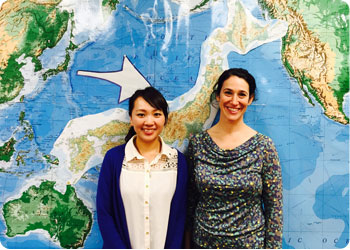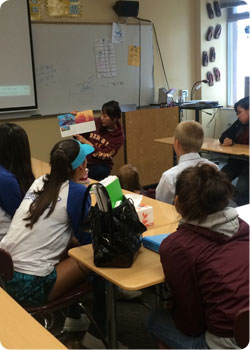

 2015 J-LEAP Report
2015 J-LEAP Report
A.J. Dimon High School
Anchorage, AK
Hi, I’m Mio Tsutada, an assistant teacher at A.J. Dimond High school in Anchorage, Alaska. My lead teacher is Ms. Victoria Gellert. As a J-LEAP assistant teacher, I am enjoying many new experiences. The best part of this program is the co-teaching. I had heard about the benefits of co-teaching previously, but now that I am actually helping in everything from the planning, to the instruction, and assessments, I’m experiencing the impact of having two teachers in a classroom working together toward the same goals.
Let me tell you a little bit about Anchorage, Alaska. First of all, the scenery is terrific. Whether I am walking out of school at the end of the day, or out in nearby Chugach National Park, the views of the mountains and Cook Inlet are always stunning. When I first got here in the beginning of August, the sun didn’t set until around 11:00pm. With winter coming, the days are gradually getting shorter. It will be quite a change in mid-December when we are teaching the third class of the day, and the sun is just starting to come out!
Recently, I was pleased to find out that Alaska has an active community of world language teachers. On September 18-20, I attended the AFLA (Alaskan’s For Language Acquisition) Conference and learned a lot about the need for comprehensible input in second language acquisition, and how to include the target-language culture more explicitly in class. I also gained ideas for presenting new vocabulary.
Anchorage is special because it is home to a K-12 Japanese Immersion Program, one of only two such programs in the US. The Immersion Program students complete their last four years at A.J. Dimond High School. At the Immersion Program Completion Ceremony, graduates give speeches in Japanese and receive a prestigious cord that recognizes their achievement of completing the Immersion Program. It’s an honor to teach their last years of Japanese.
Although having one Japanese teacher at an American high school can be rare, Dimond High School is especially unusual because there are three Japanese teachers. All together, they teach a total of 12 sections of Japanese classes. In the high school, students study Japanese through novellas, articles about current events, songs, and movies. Two special classes offered at the high school are AP Japanese Language and Culture class, and a class called Honors Japanese. The Honors class has a very unique program called the Adopt-A-Student Program (AASP). In AASP, students spend three hours each month outside of the classroom together with a Japanese native speaker. The Adopt-A-Student hosts and students make this time enjoyable by doing things like going shopping, cooking, and talking about each other’s backgrounds...all while speaking Japanese. The great part about this program is that students can use their Japanese outside of class to interact with native Japanese speakers. After meeting my AASP students at a kickoff party later this month, we will start our monthly meetings. Through the Adopt-A-Student Program, I’m looking forward to hearing about what high school students are interested in and how Japan and its culture attract them.
 Classes started on August 18th. I have been in the classroom for only a relatively short time so far, but there are many interesting things I am picking up. For example, students in the Immersion Program have studied together since kindergarten, so I can tell that students feel comfortable in Japanese class. They are like a big family. Also, this is my first time teaching without using a textbook. Everything is new to me and I already have learned many things. When I taught previously, I would teach easy grammar items, and then move on to more difficult grammar. However, Ms. Gellert teaches new expressions and sentence structures through materials and from songs, so students learn Japanese without consciously “memorizing.” She draws a lot from Comprehensible Input methods, which I didn’t know much about prior to coming to Alaska. At the J-LEAP interview I said I want to learn new ways of teaching, so I think they gave me a great chance to learn a new approach. With Comprehensible Input methods, input through listening and reading is the main focus, so teachers should wait until students are ready to output on their own. I was surprised that students start to speak what they learn when they are ready to use it. I was thinking that learners should practice grammar points using drills, like how to conjugate verbs, but I learned that it is not the only way to study a language. Ms. Gellert notices when there are students who are having trouble following along and shifts to easier questions to clarify what we are studying for the students. She always pays attention to every student. I noticed that student’s reactions are different in each class, even if we are doing the exact same lesson plan. I rediscovered that teachers and students make class together. Ms. Gellert and I plan our classes together. Luckily, Ms. Gellert is a teacher who listens to my ideas and thinks how to insert the ideas in class. I didn’t know it could be so much fun to teach with another teacher.
Classes started on August 18th. I have been in the classroom for only a relatively short time so far, but there are many interesting things I am picking up. For example, students in the Immersion Program have studied together since kindergarten, so I can tell that students feel comfortable in Japanese class. They are like a big family. Also, this is my first time teaching without using a textbook. Everything is new to me and I already have learned many things. When I taught previously, I would teach easy grammar items, and then move on to more difficult grammar. However, Ms. Gellert teaches new expressions and sentence structures through materials and from songs, so students learn Japanese without consciously “memorizing.” She draws a lot from Comprehensible Input methods, which I didn’t know much about prior to coming to Alaska. At the J-LEAP interview I said I want to learn new ways of teaching, so I think they gave me a great chance to learn a new approach. With Comprehensible Input methods, input through listening and reading is the main focus, so teachers should wait until students are ready to output on their own. I was surprised that students start to speak what they learn when they are ready to use it. I was thinking that learners should practice grammar points using drills, like how to conjugate verbs, but I learned that it is not the only way to study a language. Ms. Gellert notices when there are students who are having trouble following along and shifts to easier questions to clarify what we are studying for the students. She always pays attention to every student. I noticed that student’s reactions are different in each class, even if we are doing the exact same lesson plan. I rediscovered that teachers and students make class together. Ms. Gellert and I plan our classes together. Luckily, Ms. Gellert is a teacher who listens to my ideas and thinks how to insert the ideas in class. I didn’t know it could be so much fun to teach with another teacher.
To close, I’d like to talk about my goals for the next two years. I met a 1st year J-LEAP Assistant Teacher when I worked at the University of Wyoming. At the time, I remember thinking that it sounded like a wonderful program. I didn’t think I could be a part of this program 5 years later. I want to learn and continue to gain skills. Also, I want to get skills using Comprehensible Input and I want to be able to organize my own class because right now I need Ms. Gellert’s help when I teach. Once I can accomplish this, then I can say that I am team teaching. There’re many way to do co-teaching and I want to try many ways of co-teaching as much as possible.